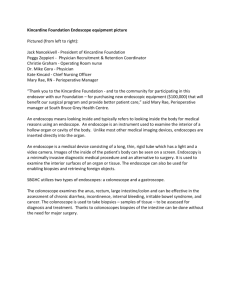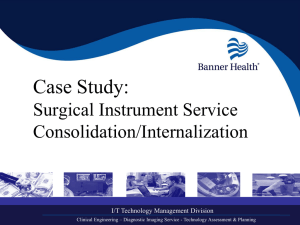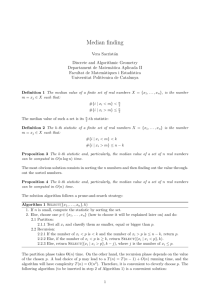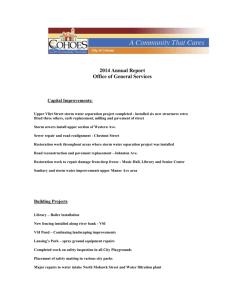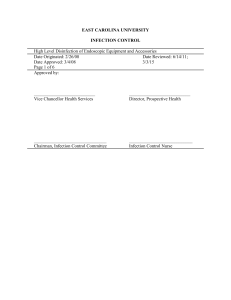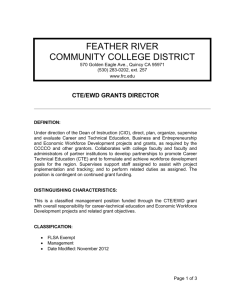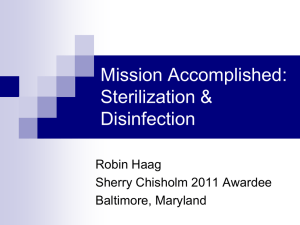RE/ 09-12 Genesis Medical Ltd t 020 8451 4100 7 Trojan Business
advertisement
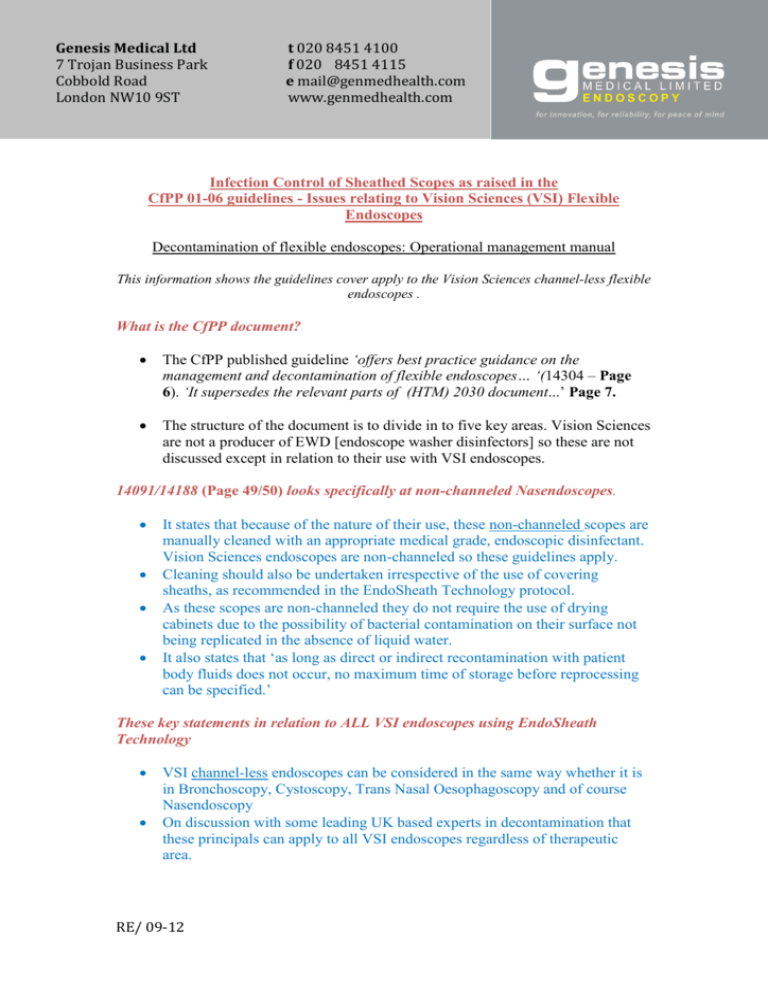
Genesis Medical Ltd 7 Trojan Business Park Cobbold Road London NW10 9ST t 020 8451 4100 f 020 8451 4115 e mail@genmedhealth.com www.genmedhealth.com Infection Control of Sheathed Scopes as raised in the CfPP 01-06 guidelines - Issues relating to Vision Sciences (VSI) Flexible Endoscopes Decontamination of flexible endoscopes: Operational management manual This information shows the guidelines cover apply to the Vision Sciences channel-less flexible endoscopes . What is the CfPP document? The CfPP published guideline ‘offers best practice guidance on the management and decontamination of flexible endoscopes… ‘(14304 – Page 6). ‘It supersedes the relevant parts of (HTM) 2030 document...’ Page 7. The structure of the document is to divide in to five key areas. Vision Sciences are not a producer of EWD [endoscope washer disinfectors] so these are not discussed except in relation to their use with VSI endoscopes. 14091/14188 (Page 49/50) looks specifically at non-channeled Nasendoscopes. It states that because of the nature of their use, these non-channeled scopes are manually cleaned with an appropriate medical grade, endoscopic disinfectant. Vision Sciences endoscopes are non-channeled so these guidelines apply. Cleaning should also be undertaken irrespective of the use of covering sheaths, as recommended in the EndoSheath Technology protocol. As these scopes are non-channeled they do not require the use of drying cabinets due to the possibility of bacterial contamination on their surface not being replicated in the absence of liquid water. It also states that ‘as long as direct or indirect recontamination with patient body fluids does not occur, no maximum time of storage before reprocessing can be specified.’ These key statements in relation to ALL VSI endoscopes using EndoSheath Technology VSI channel-less endoscopes can be considered in the same way whether it is in Bronchoscopy, Cystoscopy, Trans Nasal Oesophagoscopy and of course Nasendoscopy On discussion with some leading UK based experts in decontamination that these principals can apply to all VSI endoscopes regardless of therapeutic area. RE/ 09-12 On review of the validated processes and protocols outlined by VSI, the experts agreed the Endosheath® Technology maintained the highest levels of patient and user safety Contact details of the experts are available on request for validation of these opinions What is the VSI Endosheath® product offering? VSI Endoscopes are channel-less flexible endoscopes over which a specific external Endosheath® is fitted This provides a sterile insertion tube in contact with the patient rather than (usually) a high level disinfected scope provided by the EWD. The Endosheath®/endoscope combination means the scope never directly makes contact with the patient. The sterile working channel is incorporated in the Endosheath® and never touches the endoscope Each Endosheath® provides a single use sterile product The working channel is new and sterile for each patient The risk of cross contamination is vastly reduced because the working channel is disposed of after each case CfPP guidelines – specific points of relevance Personnel Section 14069(Page 9) states Training should be provided for all staff involved in the decontamination of flexible endoscopes. Genesis Medical provides comprehensive training packages in the form of presentations, supporting materials and training competencies for the users of its products, to ensure they are fully equipped to use the product correctly and in accordance with the validated protocol. Types of EWD and cycles Section 14073/14165 (Page 17) discusses the use of EWD devices. VSI Endoscopes can be re-processed in an EWD Like all manufacturers of endoscopes, VSI would firstly ensure chemical compatibility and functional compatibility with the specific EWD Size and Numbers of EWD’s Section 14076/14168 (Page 23) discusses the need to assess how many EWD’s a facility may require. There is no formal requirement for VSI scopes to undergo EWD reprocessing between every case (providing the endoscope is not grossly contaminated) 2 RE 09-12 Genesis Medical Ltd 7 Trojan Business Park Cobbold Road London NW10 9ST t 020 8451 4100 f 020 8451 4115 e mail@genmedhealth.com www.genmedhealth.com The overall number of EWD machines required may be reduced as the main reason for multiple EWD’s is to maintain efficiency within the Endoscopy service on offer (and indeed Endoscopes as highlighted in section 14169 and 14170.) (Page 24) VSI scopes are reprocessed in between cases using a validated protocol consisting of intermediate level disinfection cleaning regime combined with an aseptic technique for loading a sterile Endosheath® for each patient highlighted in sections 14169 and 14170 (Page 24). Reprocessing 14078/14173(Page 27) points to the use of disposable or re-usable reprocessing accessories, such as cleaning brushes, cleaning tools, endoscope valves and water bottles. The guidelines refer to the need to for single use items, which can incur additional cost. Reusable items for these purposes also incur ongoing costs as functional inventory must be maintained, meaning additional cleaning and maintenance costs. VSI scopes have no channels and removes the need for many of these items EWD operation, and endoscope storage and transportation 14083 (Page 33) points out the difficulties in inspection of flexible endoscope long narrow lumens (working channels) and that these require connection to the EWD. VSI working channels are part of the sterile disposable sheath so there are no decontamination difficulties Decontamination of Endoscopes 14186 (Page 41/42) discusses the need of the user to follow the manufacturers’ guidelines for cleaning. VSI provides this in data form, presentation/visual aids and formal training competency documents Conventional channeled endoscopes require essential manual cleaning due to the direct contact with the patient VSI endoscope cleaning is prophylactic when used with the Endosheath® in accordance with the manufacturer’s guidelines. 14187(Page 42) discusses in depth the process stages of an EWD RE/ 09-12 This is 9 specific points which must be performed exactly in order to prevent failing the cycle or alarming the EWD due to incorrect set up VSI endoscopes removes this issue. 14190 (Page 45/46) highlights issues in the transportation of HLD cleaned flexible endoscopes Additional equipment (transportation trays with a two covers) is required for moving contaminated/decontaminated endoscopes. These trays will also require cleaning and decontamination. Using VSI endoscopes that do not require the routine use of EWD’s removes the issues highlighted here with transportation Decontamination of Nasendoscopes 14091/14188 (Page 49/50) looks specifically at non-channeled Nasendoscopes. It states that because of the nature of their use, these non-channeled scopes are manually cleaned with an appropriate medical grade, endoscopic disinfectant. Cleaning should also be undertaken irrespective of the use of covering sheaths, but crucially does not exclude the use of such sheaths. In addition, as these scopes are non-channeled they also do not require the use of drying cabinets due to the possibility of bacterial contamination on their surface not being replicated in the absence of liquid water. It also states that ‘as long as direct or indirect recontamination with patient body fluids does not occur, no maximum time of storage before reprocessing can be specified.’ These are significant and key statements in relation to ALL VSI endoscopes using Endosheath® Technology VSI scopes are also channel-less and as such can be considered in the same way whether it is in Bronchoscopy, Cystoscopy, Trans Nasal Oesophagoscopy and of course Nasendoscopy On discussion with some leading UK based experts in decontamination that these principals can apply to all VSI endoscopes regardless of therapeutic area. On review of the validated processes and protocols outlined by VSI, the experts agreed the Endosheath® Technology maintained the highest levels of patient and user safety Contact details of the experts are available on request for validation of these opinions Sections 14095 (Page 56) to 14099/14206 (Page 65) look at chemical compatibility with EWD’s as well as enzymatic detergents, and flexible endoscopes A full list of compatibility is available upon request VSI endoscopes are generally compatible with the common used chemicals in the UK. 4 RE 09-12 Genesis Medical Ltd 7 Trojan Business Park Cobbold Road London NW10 9ST t 020 8451 4100 f 020 8451 4115 e mail@genmedhealth.com www.genmedhealth.com Traceability All VSI Endosheath® packaging have tracking LOT number labels in triplicate on the exterior of the sterile package Endosheath® Tracking can then be maintained to the highest standards, in addition to any tracking/traceability brought about by periodic use of the EWD system An example of the Journey of an endoscope through the system Section 14218 (Page 76) outlines the manual cleaning phase of scope reprocessing, VSI endoscopes do not require routine use of EWD systems Section 14218 outlines the manual cleaning phase of scope reprocessing, which can be maintained with the Vision Sciences’ scopes. The process would routinely change to the appropriate protocol for the specific endoscope and Endosheath® combination being used, as outlined in the training competencies and resources provided by VSI IF gross contamination is suspected or the local protocol dictates periodic use of the EWD system then this can be conducted in accordance with CfPP 0106’s guidelines. Summary The unique nature of the VSI Endosheath® Technology system gives rise to some key differences when comparing to traditional channeled flexible endoscopes Despite the differences, the majority of assigned protocols and directives of CfPP 01-06 can be adhered to The inclusion of sheaths in the document means Clinicians can be assured of maintaining adherence to the guideline, whilst significantly reducing risk of cross bio-contamination and improving operating efficiency. RE/ 09-12
